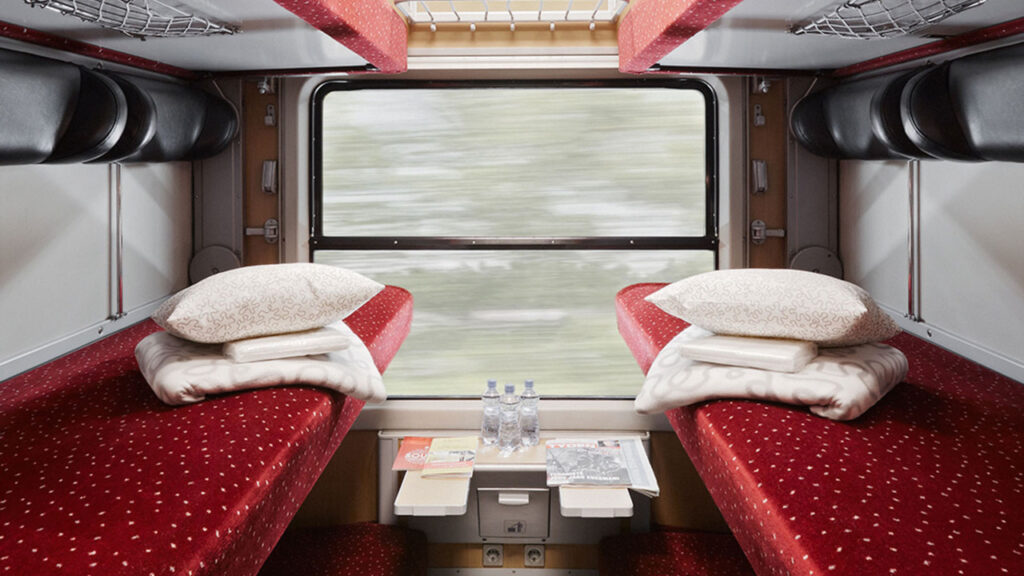In May this year the first night trains will set off from Brussels to Berlin. Tickets went on sale this week, meaning the German capital is now a mere night’s sleep away. As night trains make a roaring return to Europe’s railways, it’s worth asking: is this the future of travel?
At first glance, the answer is yes: in the last two years sleeper routes have sprung up all across Europe, their arrival greeted with widespread media fanfare. Partly, of course, this excitement is due to the climate crisis, which makes the search for green travel alternatives ever more urgent. But perhaps it also has something to do with the mystique of sleeper trains, the sense that they hark back to a bygone, more glamorous age of travel?
The allure of the sleeper train has a long history. In The Man Who Watched the Trains Go By, Georges Simenon writes of ‘a certain furtive, almost shameful emotion that disturbed him whenever he saw a train go by, a night train especially, its blinds drawn down on the mystery of its passengers’. Agatha Christie taps into the mystery of the sleeper train in her classic detective novel Murder on the Orient Express. These night trains of the imagination are glittering relics of the steam age, settings for furtive romance, for adventure, for champagne and caviar, for devious plots and cerebral sleuthing.
But what is the reality today? The era of porters and restaurant cars has largely vanished, and the modern sleeper is an altogether different beast than its twentieth-century predecessor: a perfunctory means of getting from A to B by night. Rarely are today’s sleeper trains luxury vehicles for the super-wealthy; nowadays they have become functional green alternatives to air travel, in some cases emulating all the charm and comfort of a cheap budget airline in the process.
This is not to say that flying is generally more comfortable than rail travel. But it has two distinct advantages: speed and affordability. At present, a daytime train journey from Brussels to Berlin will take almost seven hours with a change in Cologne. And unless you plan well ahead, it can cost you a small fortune. With flights from Zaventem whisking you to Berlin in one-and-a-half hours for a similar or lower price, even the most environmentally conscious traveller will be tempted to fly. (This of course may change when Ryanair closes its base at Zaventem.)
It is the first of these two advantages that sleeper trains seek to balance out: the extra time spent travelling by train is mitigated by the fact that you are asleep while you’re doing it. In theory, it should not matter that the journey takes ten hours if you aren’t awake to notice. Like a sci-fi astronaut in a stasis chamber, you fall asleep in one city and wake up rested and refreshed in another, ready for breakfast and a full day of sightseeing, your ten-hour journey little more than a pleasant dream.
But this has rarely been my experience. While a bed guarantees a certain level of comfort, for reasons of economy I have always opted simply for a seat. Whether from London to Glasgow or Amsterdam to Innsbruck, most sleeper routes will charge well over €100 for a bed in a shared cabin, and vastly more for a private cabin. This leaves the price-conscious traveller with no other option than a seat in a shared compartment or a standard carriage.
But sleeping in a seat is often a challenge. You might find yourself pressed up against a complete stranger; you might be sharing your carriage with a heavy snorer. Passengers will stumble against you as they totter up the aisle to the bathroom, each time jerking you awake. Hardly a recipe for a good night’s sleep. What’s more, even a seat can cost over €100 if booked at the last minute. How galling for the conscientious traveller to find that the cheapest option is often simply to fly.
In spite of this, I’ve no doubt I’ll be riding the night train to Berlin sooner or later – most likely in a seat. I’m sure it’ll take no more than a day for the exhaustion to wear off. But if overnight train travel is really to replace flying, it has to become more comfortable and above all more affordable.
Work is already underway. In January, the European Commission announced 10 new cross-border rail services, several of which are sleeper trains. The aim is to make train connections across Europe cheaper and more frequent. The DiscoverEU project, another EU initiative, helps 18-year-olds to travel across Europe by rail, thus encouraging sustainable travel. If sleeper trains really are the future of travel, then projects such as these are surely a step in the right direction.
With any luck the new generation of sleeper trains will steadily overtake flying in popularity. Maybe someday they’ll elicit those same ‘furtive emotions’ to which Simenon alluded in The Man Who Watched the Trains Go By. But until then my fellow passengers and I might well disembark as before, blinking and sleep-deprived, into the harsh morning light of Berlin wondering: ‘Why didn’t I just fly?’


